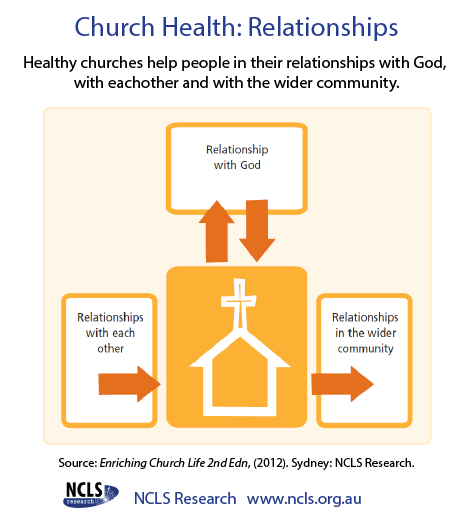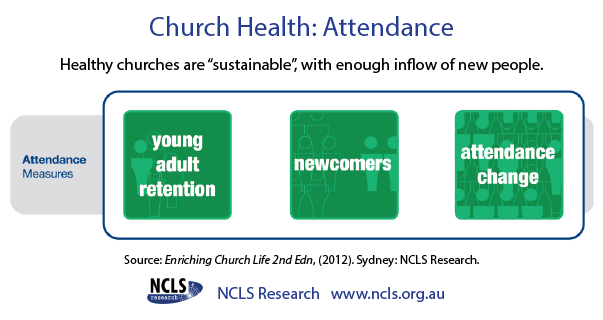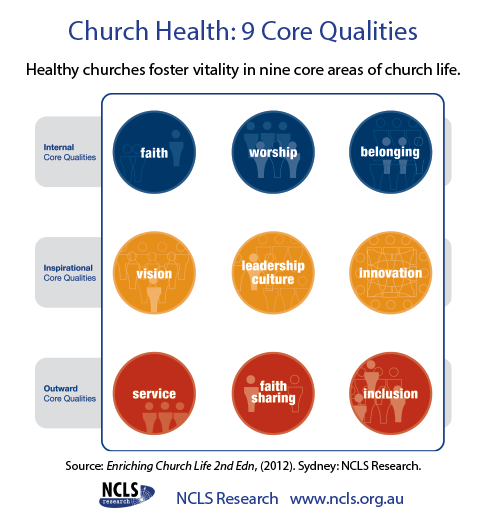After months of disconnected congregational life, what does a healthy church look like in 2021?
Over 30 years, NCLS Research has studied church health and vitality within changing times. And this year, within challenging social restrictions, we continue to help churches nurture their health. Perhaps more important than ever, we encourage churches to help churchgoers to strengthen their relationships with God, with each other and with the wider community.
Returning our focus to the essence of relationships in a healthy church model, might assist church leaders, as they reflect on and reshape their ministry, whether churches are gathering online, in small groups or at a distance.
What is meant by the term “healthy church”?
Is a healthy church identified by its characteristics? Do we know a church is healthy when we see it doing particular practices?
Who decides if a church is healthy, and why? What parameters have been applied when a label is slapped on a healthy church?
Defining Church Vitality
Church vitality has general parallels with other not-for-profits in their organisational effectiveness.
Some commentators look to see if a church is healthy by whether or not it is growing numerically. This is a simple quantitative measure. It’s straight forward and reflects the Matthew 28: 18-20 passage “go, therefore, and make disciples of all nations”.
Conversely, the other main measure of church vitality considers various qualitative elements. This picks up perspectives from multiple stakeholders – the long-term member, the visitor, the newcomer.
At NCLS Research, we have a fairly solid and consistent list that we recognise in reading church vitality literature.
Aspects found in a review of literature are: community, outward focus, leadership, spirituality, worship, discipleship, prayer, vision, caring for the young, giving, open and flexible innovation, healing, diversity, beauty and attendance (numerical growth, young adult retention and newcomers).
The NCLS Research model is goal-focused. It investigates what a church ought to achieve.
Church Health in Relationships
Our 30-year model has found that healthy churches help people in their relationships: with God, by strengthening religious beliefs and practices in faith matters; with each other, so that people feel they belong; and with the wider community, making an impact through word or deed in the society around them.
If a church is doing that, a church is doing what it is supposed to do.

Church Health in Attendance
Healthy churches are also “sustainable” in terms of their attendance with an inflow of new people.
Inflow is measured by young adult retention (teenagers and youth growing into adult attenders), newcomers, and attendance change.
One of our UK colleagues says that a reason for church decline is the failure to replace older generation attenders, and that it’s easier to retain young churchgoers, than it is to attract people who are unchurched. In other words, we need to look at hanging on to our own children because there is a generational erosion taking place.

Church Health in Leadership and Direction
Healthy churches also have vital leadership and directions for the future.
This is about the capacity or readiness for action within a church. Such actions are: empowering leadership that includes others, clear and owned vision, goals or direction for the church, a readiness to innovate and try new things, and confidence in the church.
Church Health in Nine Core Qualities of Church Life
The NCLS Research Core Qualities Model
The Core Qualities model was developed from the 1991 National Church Life Survey (Kaldor et al, 1992) onwards and involve 20+ denominations. The responses were based on the perspectives of people in the pews.
There have been various configurations but the same core concepts have remained. This is primarily large-scale quantitative research, with both strengths and limitations.

The model of nine core qualities and three attendance measures form the basis of the model used by NCLS Research for evaluating church vitality via a Church Life Survey. Further information about the background research underlying the Core Qualities framework can be read here.
Challenging times for church vitality
The recent years of the COVID-19 pandemic and it's social isolation measures have added incredible complexity to church life in our country. The shape of religion in Australia is changing and so are the modes of gathering and worship as COVID-19 measures evolve.
It may be more important than ever to connect with churchgoers and understand the impact of this pandemic across the country. Returning our focus to the essence of relationships with God, each other and the wider community might assist church leaders, as they reflect on and reshape their ministry.
The models of church health listed above will be used in the 2021 National Church Life Survey, to help churches to reflect on their church health. By evaluating the present, the goal is to equip churches to take action for the future. This year's NCLS will provide participating churches with credible, localised insights about spiritual and pastoral strengths and national trends, to help them plan for the church of tomorrow.
The survey includes questions specific to churchgoer's experiences of COVID-19 to understand the impact of this pandemic on church life across the country. Adaptable survey options, paper and online, allow a church to listen to their churchgoers and local community members, whatever their mode of gathering, either together as a group or individually. More information on how the 2021 NCLS addresses issues related to the COVID-19 restrictions can be found at 2021ncls.org.au/covid .
Whether gathering in person, in small groups, online or at a distance, churches are encouraged to reflect on what nurtures health amongst their churchgoers, leaders and community at this time. It is hoped that learning from other leaders, as well as insights from over 30 years of research, may provide encouragement and strength to church leaders as they continue to adapt and respond to the circumstances. Browse the related articles below for more, including church leaders sharing their experiences of nurturing church health during social isolation.
Kathy Jacka and Ruth Powell, NCLS Research with Rod Bennett, WildHive Studios.



